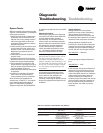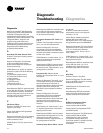
SCXG-SVX01B-EN 111
Table D-T-1. Common Unit Problems and Solutions
Problem Possible Cause Remedy
Drain pan is overflowing Plugged drain line Clean drain line
Unit not level Level unit
Standing water in drain pan Unit not level Level unit
Plugged drain line Clean drain line
Wet interior insulation Coil face velocity too high Reduce fan speed
Improper trap design Design trap per unit installation instructions
Drain pan leaks/overflowing Repair Leaks
Condensation on surfaces Insulate surfaces
Excess Dirt in unit Missing filters Replace filters
Filter bypass Reduce filter bypass
Microbial growth (mold) Standing water in drain pan See “Standing water in drain pan” above
Moisture problems See “Wet interior insulation” above
System Checks
Before proceeding with technical trouble
charts or controls checkout, complete the
follow system analysis:
1. Measure actual supply voltage at the
compressor and an motor terminals
with the unit running. Voltage must be
within the range listed on the motor
nameplate. Phase imbalance must be
less than 2.0 percent.
2. Check all wiring and connections to be
sure that they are intact, secure and
properly routed. The as wired system
diagrams are provided in the unit
control panel.
3. Check that all fuses are installed and
properly sized.
4. Inspect air filters and coils to bel sure
that airflow to the unit is not restricted.
5. Check the zone thermostat settings.
6. Ensure that the fan is rotating in the
proper direction. If phasing is wrong at
the main power terminal block, the fan
and compressors will not run.
7. Inspect ductwork and duct connections
for tightness.
8. Inspect air temperature. Extremely
warm return air will decrease the
cooling capacity of the air conditioner.
Some common unit problems and
solutions are in Table D-T-1. A complete
list of operating diagnostics begin on
page 112. Reference the
IntelliPak
®
Programming Guide, PKG-SVP01B-EN,
Diagnostic
Troubleshooting
for additional operational info on the UCM
system.
Operating Procedures
Install pressure gauges on the discharge
and suction line access valves. When the
unit has stabilized (after operating
approximately 15 minutes at full load),
record suction and discharge pressures.
System malfunctions such as low airflow,
line restrictions, incorrect refrigerant
charge, malfunctioning of expansion
valves, damaged compressors, and so
on— will result in pressure variations
which are outside the normal range.
Note: If phasing at the main incoming
power terminal is incorrect, switch two of
the three incoming power leads. If a
compressor has been replaced and the
phase is changed at the compressor, it will
run backwards and discharge pressure will
be very low. To resolve incorrect compres-
sor wire phasing, change phasing at the
compressor.
It is important that pressures be mea-
sured under stable and constant condi-
tions in order for the readings to be
useful. The unit mounted, remote
mounted, or discharge air setpoint can be
temporarily adjusted to simulate full load
conditions.
Voltage Imbalance
Voltage imbalance on three-phase
systems can cause motor overheating
and premature failure. Maximum
allowable imbalance is 2.0 percent, and
the readings used to determine it must be
measured at the compressor terminals.
Voltage imbalance is defined as 100
times the sum of the division of the three
voltages from the average voltage. If, for
example, the three measured voltages
are 221, 230, 227, the average would be:
(221+230+227) = 226 volts
3
The percentage of voltage imbalance is
then:
100*(226-221) = 2.2%
226
In this example, 2.2 percent imbalance of
more than 2.0 percent exists, be sure to
check the voltage at the unit disconnect
and terminal block switch. If an imbalance
at the unit disconnect switch does not
exceed 2.0 percent, the imbalance is
caused by faulty wiring within the unit. Be
sure to conduct a thorough inspection of
the unit electrical wiring connections to
locate the fault, and make any repairs
necessary.
Troubleshooting


















